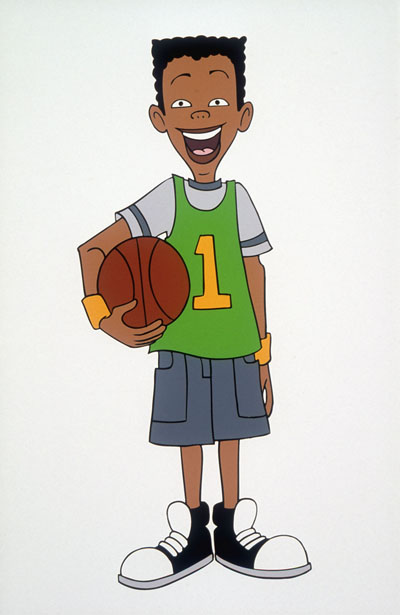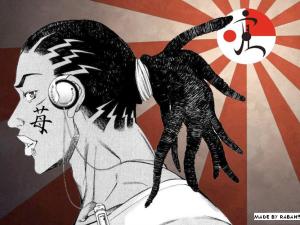You are using an out of date browser. It may not display this or other websites correctly.
You should upgrade or use an alternative browser.
You should upgrade or use an alternative browser.
Salute to all the African- American Cartoon Characters.
- Thread starter Oceanicpuppy
- Start date
More options
Who Replied?ManBearPig
half man half bearpig
Vince from Recess

He act white as hell. U wouldn't like him less if he was white?
OfTheCross
Veteran
Breh, have you seen his brother?He act white as hell. U wouldn't like him less if he was white?
He's a certified Coli 6 cert nikka if I every seen one. Dude is Blacker than black
Funny thing is, he was good at sportsHe act white as hell. U wouldn't like him less if he was white?


"What's the sitch?"
Last edited:

This isn't even all of his characters
loyola llothta
☭☭☭
WyldStyle
Black Love
Define "acting white"He act white as hell. U wouldn't like him less if he was white?

DO BLACK PEOPLE REALLY DO THIS STUFF? Manga and Anime

Amber; cover by James Eugene; from the YA novel by Milton Davis
Yesterday, it was announced that author Milton Davis, Yours Truly and artist Sarah Bowman (Macklin) – known worldwide as S-Sama – will collaborate to create the manga version ofAmber, a YA novel penned by Milton Davis.
Milton will publish; I will write the graphic script and Sarah will illustrate the work.
For those who are scratching their heads, wondering just what the heck ‘manga’ is, ask any teenager in the world and they can tell you. If no teenager is nearby, read on.
‘Manga’ is the Japanese word commonly used as the name of the genre for all comic books or graphic novels published in Japan. Manga has a certain style, recognizable in its artwork and in its literary tropes.
While manga is typically read by teenagers outside of Japan, there are publications aimed at both children and adults.

Bob Makihara, from the manga “Tenjou Tenge” by Oh! great (Ito Ogure).
In Japan, however, all ages read manga, which is considered literature rather than “just a comic book”. In Japan, manga is so popular its yearly sales reach the billions.
Manga is often adapted into animated television programs and films called ‘anime’. Examples include Pokémon, Naruto, Yu-Gi-Oh!andmy personal favorite, Death Note.

Krag of Kragmire, “The First Steampunk”.
Like most people born in America, my introduction to the Japanese style of graphic storytelling began with anime. As a four year old, I would sit in awe as I witnessed the adventures of Prince Planet – known in Japan asPlanet Boy Papi – which tells the story of Prince Planet – a member of the Universal Peace Corps – from the planet Radion, who is sent to Earth to determine if our world meets standards for membership in the Galactic Union of Worlds and to assist its inhabitants during his stay. While on this mission, Prince Planet adopts the identity of an Earth boy named Bobby (‘Papi’) who, along with a band of human comrades, fights the forces of evil, both alien and terrestrial. In fact, my favorite villain of all time, who I call the “first Steampunk”, is Krag of Kragmire, Prince Planet’s greatest nemesis.
A couple of decades later, I introduced my children to the anime film Princess Mononokeand thus began their love of the art form. I later got them hooked on Death Note – the anime and the manga. Now, one of my daughters is so into manga and anime, she has become fluent in Japanese and Korean and plans to write manga of her own.

Miyuki Ayukawa, from the anime / manga, “Basquash” by Tetsuya Hayashi.
Black people in the United States – like nearly everyone else – have been heavily into anime since the early 70s and into manga since the early 90s. The well-plotted stories, incredible technology, fearsome creatures, cool characters, over-the-top comedy and eye-popping action are masterfully combined to make science fiction and fantasy palatable for all.
Most fans of the genre are unaware, however, that the visual approach and concepts of manga was introduced to the Western world by a Black man – Vernon Ethelbert Grant.

Vernon E. Grant, father of Western manga / anime.
Grant, known for his digest-sized comic book series,The Love Rangers, was born February 14, 1935. Always artistically inclined, Grant earned money as a child by drawing cartoons for birthday cards. After graduating from Ridge Technical High School in Cambridge, Massachusetts, he studied for a year in Boston at the Vesper George School of Art and then joined the Army in 1958 at the age of 23.
While in Europe as an airborne and air assault sergeant, Grant studied Japanese and French.
Grant was eventually sent to Tokyo, where he worked as a regular cartoonist for Stars and Stripes – the official newspaper of the Unites States Army. It was in Tokyo that he developed a strong fascination with Japanese comics. He also wrote and drew for Japan’s English-language newspapers, including the Mainichi Daily News.
In the late 1960s, while in Vietnam, Grant became interested in comic books. As he recalled: “When I purchased a French comic magazine in Saigon in 1967, it was the first comic book contact that I had in more than ten years. It reminded me of my early experiments with drawing color comics in grammar school…In 1968 I was discharged from the United States Army in Japan and began studies in Japanese history and culture at Sophia University in Tokyo…In 1972, while still in school, I saw and read my first issue of an underground comic book, The Fabulous Furry Freak Brothers. This publication was quite an interesting item for me. I had heard of underground comic books but had, until that time, never seen one. I was very impressed.”
During the years he lived in Japan, Grant wrote and drew several graphic novels, including the two-volume military satire, Point-Man Palmer and A Monster is Loose in Tokyo (Tuttle, 1972) about the life of a foreigner in Japan.

The Love Rangers, by Vernon E. Grant.
When he returned to Cambridge, he created The Love Rangers, his science-fiction comic book series about a racially mixed space crew traveling the universe. Between 1977 and 1988, Grant published seven issues of The Love Rangers in a 36-page, 5½”x8½” format.
The series follows the lives and adventures of a number of officers, robots and members of a squad of genetically engineered Love Rangers that live on the spaceship called “Home”. It is an immense structure, housing 35,000 individuals on its seven levels. While some of the action in the stories takes place on board, many of the episodes in his comic books take place on planets they visit. The ship is commanded by a male and female Shipmaster who share equally in all responsibilities. One of the dominant characters is Princess Tomi, who single-handedly leads her Mice People in their battle against the Owls for survival. There are robots and devices in the ship that the U.S. military incorporated some ten to 15 years after Vernon had already incorporated them into his series. The fuel that powers the ship is the feelings of discord and hate that emanates from different parts of the universe. At times the Love Rangers have to use weapons to control the warring inhabitants of the different planets they visit, but they attempt to first use their “love gas” to change the path of history. In the first book, the love gas helps change the consciousness of Count Ratalus from having a killing drive to flooding his mind with an understanding of history as well as nature’s instinctive patterns. When this happens, a well of human compassion overrides his coded savagery. He stops himself from killing Prince Tug, and they go off to work together peacefully for the betterment of the mice people and toward peaceful co-existence with their enemies, the Owls.
On July 7, 2006, Grant suffered a heart attack while on a daily run, injuring his head when he fell. He went into a coma and died two weeks later on July 23.
Grant’s work is included in Michigan State University‘s Comic Art Collection.

Manga / anime facial study by Setor Fiadzibey.
There are several Black mangaka, or manga creators – most unpublished, unfortunately – who are doing incredible work. Most popular among these are our own Sarah Bowman / S-Sama, the talented Latif-Saeed and the brilliant sister,Nashya.
Finally, from Ghana, is visual storyteller extraordinaire, Setor Fiadzibey, author / artist of the graphic novel Adinkra, the Legend of the Bearers, which is about a group of people, separated by tribes but united by a divine being known as the Great Weaver, an autocratic king and a common enemy known as the Shadow.
Having wrestled with the Shadow through countless generations, the Great Weaver shares his immense power with certain individuals, known as Bearers, who would deliver the people from his dark nemesis. Each Bearer is born with an adinkra symbol that grants them great power and compels them to do the bidding of the Great Weaver.
Adinkra is the tale of those Bearers, their struggles with the Shadow, their struggles with their humanity – even though they have divinity in them – and their pursuit of victory over both.
Amber will soon join Adinkra in delivering an amazing manga that is sure to entertain and inspire fans of anime, manga and fantasy of all ages. Look for it in Spring, 2014.
HAPPY BLACK SPECULATIVE FICTION MONTH!
DO BLACK PEOPLE REALLY DO THIS STUFF? Manga and Anime



















